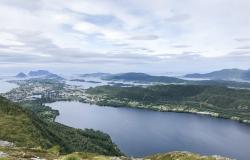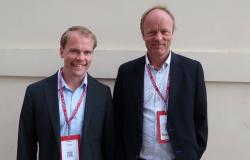Reader’s letter This is a debate entry, written by an external contributor. The post expresses the writer’s views.
Monday 22 April 2024 started with two badgers strolling peacefully around the yard, before disappearing into the forest. A little later in the day, I learned that this forest will not only be cut down, but that it will happen at the beginning of May.
That same morning, a squirrel ran past the kitchen window. It carried a brown ball in its mouth. Everything went so fast, but the ball looked very much like a baby squirrel. Outside the same window the linerla tripped. With its wagging tail, its beak was full of grass, twigs and other debris. The liner pair’s annual and traditional nest-building is in full swing. The same applies to the blackbirds that are high and low and colonies of other small birds. Some stop for a few days for a breather on their long journey from south to north. Others have more or less permanent residence in the area. They all sing in symphony both early and late. In the forest that will now be cut, early in May.
In addition to a large number of small birds, badgers and squirrels, there are also foxes, roe deer, moose, bobcats, hares, mice, lizards, frogs, toads and various worms that live here in the forest. Maybe some salamanders too, who knows. By the way, did I mention the friendly wood pigeons and the loud nut calls? Or the owls that sit and scout out over the field after the grass has been mowed around Whitsun and sometime into September. There are also bats here. Many mentioned, probably also many forgotten. They all have their lives in and around the forest that will now be cut, early in May.
We must also not forget the hawks that occasionally hover over the fields. Last week I found, not far away, a nest they are actively using. While I was walking in the forest, a large bird suddenly fluttered up from the pine crown. A couple of days later I slipped away to see if I could find my way back to the nest, I did. No life there then, but I heard their cries and scouted the countryside. It then turned out that there were two large birds circling the ground below. I don’t know for sure if it is an eagle, hawk, falcon or what. I am no ornithologist. Still, I dare to guess that it is the red-listed mouse guard we are talking about. The nest I found is located close to the forest that will now be cut, early in May.
As something bordering on crazy, almost too crazy to be completely random, and before we go any further, it can quickly be mentioned that it was a forestry manager from the local forest owners’ cooperative and an accompanying mechanical contractor on inspection, who this Monday brought to my attention the time of the felling and the area to be taken. While we were thinking out loud together in positive tones and looking at various maps, suddenly the couple, from what I assume is mouse alert, came directly over our heads, at an unusually low altitude, much lower than I have ever experienced out here. As if they were trying to tell us something. I also let the professionals know what I think about rough forestry at this time of year. But, if you are not sitting at the upper parts of the table, you have little to show for it. The industry’s counterarguments were well rehearsed. The animals have even less to say. In the evening, the same day, by the way, another very large black bird, guess it was a raven, flew in a circle right above my head, only 8-10 meters above the ground. This has not happened before either. It flew in circles in and out of the forest that is now to be cut down. It seemed, like the mouse guards, to have a message on its heart.
Back to spring’s planned felling. The ground is wet now. The patches of snow are getting smaller and fewer. It is almost completely bare. The cable is about to drop, but the soil is far from dry. It will be tracks out of another world. The forest road runs the risk of being driven completely to shreds. Still, I’m not overly concerned about this. Because such things can and must be repaired afterwards. The aforementioned professionals also promised this.
Something that is not as easy to repair, however, is cohorts with broken bird eggs and baby birds that either freeze on the ground or lie in the nest and starve to death because the mother and father do not dare to approach their place of residence, those days and possibly weeks of harvesting machines and load carrier dominates the forest. Several birds also have their nests on the ground, under stumps, among roots and in clumps of twigs. They don’t have much to contend with when the huge wheels roll forward and the long arms of the timber claws wave around them. We have all heard of David’s fight against Goliath. Little David won. It is a little more uncertain whether a baby squirrel manages to defeat a logging machine. Or what about the children of the aforementioned mouse guards, of the badgers, of deer, of foxes and hares and so on. These will not win without our help, now when it is to be cut, early in May.
That the forestry industry drags on and then neglects wildlife in what is in practice an ugly and cynical way, through logging during the short and intense period when new generations of animals see the light of day, is sad, sad as just that. And this happens despite the fact that the industry turns around with great words in party speeches, on various websites and in interviews. Some slightly freely reproduced quotes; – It must be cut in order to save the climate. – Cats kill more birds than we do. – In the deciduous forest, which we do not cut in the spring, there are seven times as many birds as in the forest we cut. In addition, we have the fact that machines and equipment are so expensive that they must be operational all year round.
If you think about it a little more carefully, the first three arguments are actually a bit comical in this context. The last aspect is the only factual argument. Because the calculations have to add up. Still, we cannot have a forest industry that sacrifices the forest’s wildlife to save Blue Russia’s pie and bar charts. We also know that there is a sea of other industries that manage to adapt to a seasonal annual cycle. Not least the individual farmer and farmer. In the forestry industry as a whole, there is such an enormous amount of money in motion, that this too must be able to handle seasonal variations in a good way without forest owners and machine contractors being left with the entire bill and thus pressured to cut down the forest, early in May.
Allow me therefore to ask; – What’s the point of raw forestry now in the spring? No, let’s rather protect the short nesting and breeding season together!






